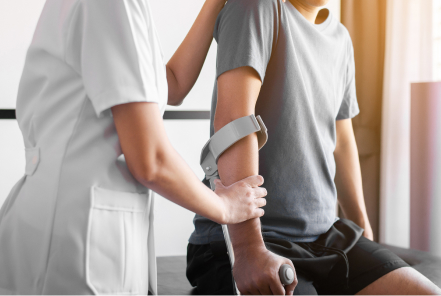Hip Surgery
Hip replacement
What Is It?
Hip replacement surgery (sometimes called total hip replacement) involves replacing damaged parts of your hip joint with metal, plastic or ceramic parts.
- It’s most commonly used to treat pain and stiffness in the hip joint caused by osteoarthritis.
- It may be recommended if other treatments or lifestyle changes have not worked and hip pain and loss of movement is affecting your daily life.
- You’ll have the operation in hospital. It can take several months to recover from surgery.
- A hip replacement can last for at least 15 years and can significantly improve daily life for people with hip pain and stiffness.


Reasons for having a hip replacement
A hip replacement may be recommended if hip pain and stiffness is having a big effect on your life and other treatments have not worked.
The most common reason you might have a hip replacement is because of problems caused by osteoarthritis. This is a condition that causes joints to become painful and stiff.
Other conditions that can also be treated with a hip replacement include:
- Rheumatoid arthritis – a condition where the immune system causes joint damage, pain and stiffness
- Pain and stiffness caused by damage to the hip after a fall, injury or accident
The hip usually moves smoothly because the ends of the bones are covered with a layer of tough tissue called cartilage. If the cartilage is worn away or damaged by an injury, the bones rub against each other, making your joint painful and stiff.
During a hip replacement, the damaged parts of your hip are replaced with metal, ceramic and plastic parts.
Hip replacements are usually very successful and most people will have less pain and better movement.
Hip Arthroscopy
Hip arthroscopy offers diagnostic and therapeutic solutions with only small scars and shorter recovery periods than with open procedures. The reasons for having a hip arthroscopy include:
- Labral tears
- Surgery for Femoroacetabular Impingement (FAI)
- Removal of loose bodies
- Osteochondral injuries
- Synovial disease
- Evaluation of undiagnosed hip pain


What is an arthroscopy?
Hip arthroscopy is performed under a general anaesthetic (you are asleep). I use small incisions, a camera and special small instruments. Using traction (a pulling force) to bring the hip slightly out of joint, I get a good view of the hip and any areas that are causing your symptoms. I am then able to carry out the necessary procedures.
What happens during the operation?
You will be positioned on a special traction table with a padded post pressing against the inside of the thigh (very close to the groin) – this is used to keep the legs in correct position. Traction is applied to each leg to allow space for the camera to pass into the hip joint. An X-ray is used to confirm that the joint is stretched opened enough to allow the camera to pass before starting the operation. X-ray is also used during the operation to help carry out certain procedures.
What are the benefits of an arthroscopy?
An arthroscopy is much less invasive than previous forms of hip surgery. This means that you have a shorter hospital stay and quicker healing than more traditional surgery. You will also be able to start your rehabilitation earlier. The hip arthroscopy also aims to remove or reduce your symptoms, including pain, instability and stiffness.
Hip resurfacing does not work well for people with weaker bones. You may be offered it if you’re aged around 50 or younger.
Hospital stay
Your operation can take from 1.5 to 3 hours, depending on how much work needs to be performed. You may need to stay in hospital overnight following your procedure. In some cases you may be able to go home on the same day (dependent on the extent of your surgery, and the time the procedure is completed). This may vary depending on your medical history and also on how you are managing to mobilise with help from the physiotherapists.

What conditions can be treated with hip arthroscopy?
Femoroacetabular impingement (FAI)
This condition involves the head of the thigh bone (femur) and the rim of the socket (acetabulum). It is caused by bumps on the femoral head causing abnormal contact with the socket, which can lead to damage of the cartilage (labrum). This in turn can cause pain. An arthroscopy can be used to reshape the femoral head and socket to prevent this abnormal contact.
Loose bodies
These are pieces of cartilage that form within the joint. They look like small marbles floating around in the joint space. They can be caused as a result of trauma, sports injury or wear and tear.
Labral Tear
The hip socket has a rim of fibrous cartilage called the labrum. It’s the gristle! This can be damaged either through abnormal contact or other causes. Common symptoms of a labral tear include a locking or catching sensation in the hip as well as groin pain.
Articular cartilage injury
Articular cartilage covers the joint surfaces of the head of the femur and inside the socket, allowing for smooth movement. Tears in this cartilage can happen from activities such as running or jumping or as a result of wear and tear.

